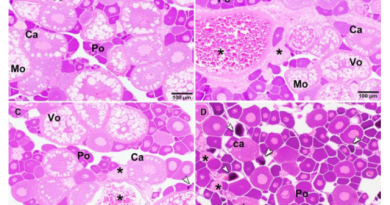Serosurveillance of Schmallenberg virus in wild ruminants in Spain
Transboundary and Emerging Diseases
Abstract
Schmallenberg disease (SBD) is an emerging vector‐borne disease that affects domestic and wild ruminants. A long‐term serosurvey was conducted to assess exposure to Schmallenberg virus (SBV) in all the wild ruminant species present in mainland Spain. Between 2010 and 2016, sera from 1,216 animals were tested for antibodies against SBV using a commercial blocking ELISA. The overall prevalence of antibodies was 27.1% (95%CI: 24.7–29.7). Statistically significant differences among species were observed, with significantly higher seropositivity found in fallow deer (Dama dama) (45.6%; 99/217), red deer (Cervus elaphus) (31.6%; 97/307) and mouflon (Ovis aries musimon) (28.0%; 33/118) compared to Barbary sheep (Ammotragus lervia) (22.2%; 8/36), Iberian wild goat (Capra pyrenaica) (19.9%; 49/246), roe deer (Capreolus capreolus) (17.5%; 34/194) and Southern chamois (Rupicapra pyrenaica) (10.2%; 10/98). Seropositive animals were detected in 81.4% (57/70; 95%CI: 70.8–88.8) of the sampled populations. SBV seroprevalence ranged from 18.8% (48/256) in bioregion (BR)2 (north‐central, Mediterranean) to 32.3% (31/96) in BR1 (northeastern or Atlantic, Eurosiberian). Anti‐SBV antibodies were not found before 2012, when the first outbreak of SBD was reported in Spain. In contrast, seropositivity was detected uninterruptedly during the period 2012–2016 and anti‐SBV antibodies were found in yearling animals in each of these years. Our results provide evidence of widespread endemic circulation of SBV among wild ruminant populations in mainland Spain in recent years. Surveillance in these species could be a useful tool for monitoring SBV in Europe, particularly in areas where wild ruminants share habitats with livestock.




